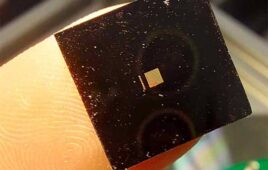
The immune system often builds up a wall of dense scar tissue around implanted medical devices, a process known as fibrosis. The cell shown in blue represents a macrophage that has been blocked from initiating fibrosis. [Image from Felice Frankel]
The body’s immune system usually attacks implanted medical devices that are used for drug delivery, sensing or tissue regeneration. Defense cells in the body try to isolate the foreign material from devices and create dense scar tissue around them. The scar tissue prevents the devices from doing what they’re supposed to.
Researchers found that blocking the molecule that is part of the fibrosis process prevents scar tissue from forming, according to an MIT news release.
“This gives us a better understanding of the biology behind fibrosis and potentially a way to modulate that response to prevent the formation of scar tissue around implants,” said Daniel Anderson, associate professor in the MIT Department of Chemical Engineering and a member of MIT’s Koch Institute for Integrative Cancer Research and Institute for Medical Engineering and Science (IMES).
Anderson, who is also an affiliate at Boston’s Children’s Hospital and the study’s senior author, has been working with scientists for several years on implantable medical devices that replicate the functions of the pancreas for diabetes patients. The device they developed encapsulates insulin-producing islet cells in an alginate material that is found in algae. The alginate doesn’t produce as much of a reaction in the human body as compared to manmade materials like metal. Nonetheless, it still created fibrosis.
The MIT researchers discovered that cells called macrophages are needed for fibrosis to occur, but if those cells are not present, medical device implants do not form scar tissue. They also discovered the signaling molecules, known as CSF1, that help macrophages mature and create fibrosis.
Blocking the cell surface receptors for CSF1 could prevent fibrosis from forming around implanted medical devices that were made from alginate, according to the researchers. It also didn’t stop the macrophages from performing their other critical functions.
“We show that you preserve many other important immune functions, including wound healing and phagocytosis, but you lose this fibrotic cascade,” said the paper’s lead author Joshua Doloff, who is also a Koch Institute and JDRF postdoc. “We’re preventing the macrophages from toggling into an activated warning state where they sound the alarm for this massive immune response to show up.”
Fibrosis was also prevented in ceramic and polystyrene devices when the CSF1 receptors were blocked.
“It’s generalizable to many different types of biomaterials, and hopefully will also be generalizable to many platforms for different purposes,” Doloff said.
Implantable devices that are used for glucose sensing, pacemakers, and devices that need to interact with surrounding tissues are generally affected by fibrosis.
Doloff and co-author on the study Shady Farah are working together to figure out a way to deliver the CSF1R-blocking drug for different types of implantable devices.
“If you use a broad-spectrum drug, you may be getting rid of cell types that are important for reducing fibrosis or even for other vital immune functions in the body — wound healing or fighting off parasites, bacteria or viral infections,” Doloff said.
JDRF, the Leona M. and Harry B. Helmsley Charitable Trust, the National Institutes of Health and the Tayebati Family Foundation funded this research. The research was published online in the Nature Materials journal.
[Want to stay more on top of MDO content? Subscribe to our weekly e-newsletter.]




